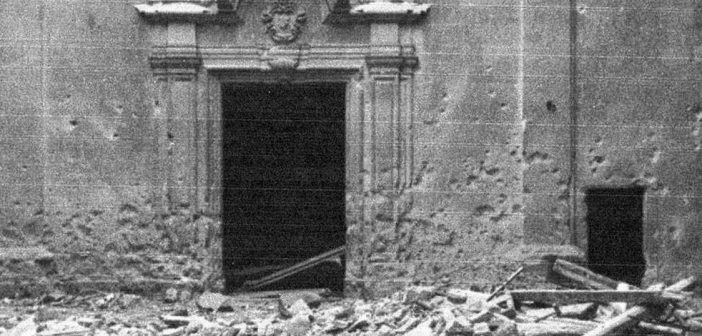Barcelona walking tour
The Spanish Civil War of 1936-1939 fought between the democratic Republicans and Nationalists led by Francisco Franco left its stamp on Catalan history. Today, these “stamps” can still be found in buildings, parks, and other locations that hold a great value but might be overlooked.
Viaje a la Barcelona Secreta offers an organized tour that reveals the Civil War history of popular locations around the city. Whilst Barcelona has many types of tours such as tasting tapas, exploring Modernist sites, this cultural tour offers an insight into a key epoch in the city’s history. While on your visit to some of the most popular destinations in Barcelona here are a few things to look out for with reference to the Civil War:
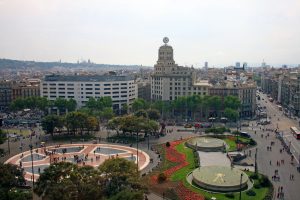 Plaça Catalunya
Plaça Catalunya
Plaça Catalunya has been at the heart of the city since the Middle Ages and remains a popular meeting place today. During the Civil War, this was the main place for exchanging information and commerce. Next time you find yourself surrounded by pigeons in Plaça Catalunya, spicture yourself surrounded by the buzzing of merchants and galloping of horses instead of today’s city noises.
Hotel Colon
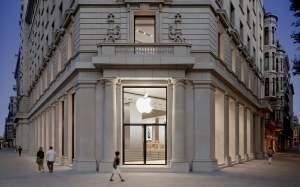 On one side of PlaçaCatalunya you can find the Apple store, which back in The Civil War era was Hotel Colon, the most luxurious hotel in Barcelona at the time. Back in 1936, Hotel Colon was explicitly for the upper class; merchants and workers were not allowed inside. However, during the Civil War the Hotel became an important symbol for the working class people as they took it over, allowing workers and the elite to mix with each other.
On one side of PlaçaCatalunya you can find the Apple store, which back in The Civil War era was Hotel Colon, the most luxurious hotel in Barcelona at the time. Back in 1936, Hotel Colon was explicitly for the upper class; merchants and workers were not allowed inside. However, during the Civil War the Hotel became an important symbol for the working class people as they took it over, allowing workers and the elite to mix with each other.
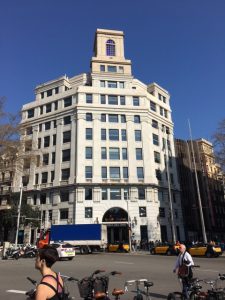 Mobile World Centre
Mobile World Centre
Opposite the Apple store is the Mobile World Centre. Today, the centre explains how forms of communications have influenced our lives. Back in the 1930s the centre was operated by women who linked calls between callers, and was therefore a very important building to have in possession during the Civil War. The army understood this and tried to take it over in a surprise attack, but they were defeated by the militia which gathered at Plaça Catalunya.
Boadas Cocktail Bar
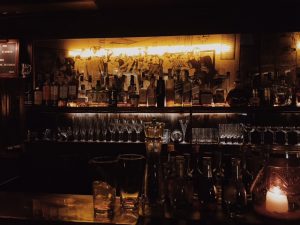 Located on the corner of Las Ramblas and Carrer Tallers, Boadas might be small yet is bound to take you back in time. It is the oldest cocktail bar in Barcelona and its original structure has been maintained since it was founded in 1933. Boadas was visited by some of the most top cultural celebrities of the time including Pablo Picasso, Ernest Hemingway, and Federico García Lorca, to name just a few. During the war, founder Miguel Boadas placed a Cuban flag both outside and inside the bar. This is believed to have kept the bar from being closed down during the war because the military might have mistaken it for the Cuban Embassy.
Located on the corner of Las Ramblas and Carrer Tallers, Boadas might be small yet is bound to take you back in time. It is the oldest cocktail bar in Barcelona and its original structure has been maintained since it was founded in 1933. Boadas was visited by some of the most top cultural celebrities of the time including Pablo Picasso, Ernest Hemingway, and Federico García Lorca, to name just a few. During the war, founder Miguel Boadas placed a Cuban flag both outside and inside the bar. This is believed to have kept the bar from being closed down during the war because the military might have mistaken it for the Cuban Embassy.
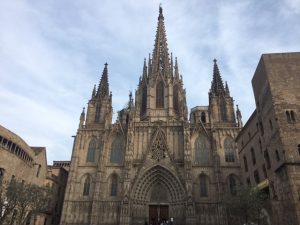 Barcelona Cathedral
Barcelona Cathedral
The building of this beautiful cathedral began slowly. However, in 1353 the black plague struck Spain and the construction of the cathedral progressed much more rapidly because the people believed the plague was a punishment from God for their laziness. As you walk along you might notice a small window towards the right outskirts of the cathedral with a saint and a blue dog.
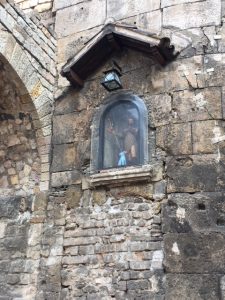
The Saint is Sant Roch or Rocco, the saint of plague or disease, in this case leprosy. During the Civil War, the cathedral was one of the many buildings affected by the bombings. After the war, Francisco Franco wanted to restore the country’s infrastructure and this included rebuilding churches and cathedrals as quickly as possible. Thus, when the saint and dog were placed on the window the dog was originally brown, but with sun exposure and time it turned blue. The people saw this as a cheap effort, but the Bishop said that the dog was blue because it was a “celestial” dog and God wanted it to be blue.
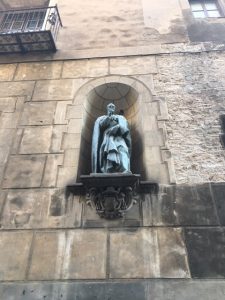
As you continue towards the back of the Cathedral on an incline, try to imagine beggars and lepers at your feet. That very incline used to be a bridge where people with leprosy would beg at the feet of others. Hence, Sant Roch was placed right above them. If you look up to your right, you’ll notice yet another statue. This is Bishop Irurita, who is known for saying that “Satan guided the hands of the the Republic” during the Civil War. He is up looking down and blessing the people as they pass by.
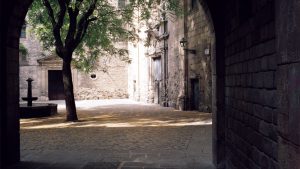
Plaça de Sant Felip Neri
This is not only the church where Antoni Gaudí would do his daily confessions, it was also a very important shelter during the Civil War. The church sheltered children during the war and was massively bombed causing the death of 42 people. On the façade of the church, you can still see bullet holes from priest executions, and bomb ruptures. These scars remain as a reminder of the consequences of war.
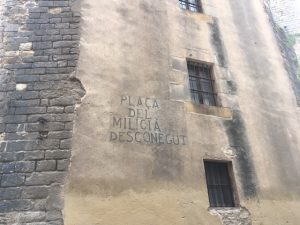
Basílica de Santa Maria del Pi
If you walk around the church and pay close attention to its façade you might be able to notice a sign that was painted at the end of the Civil War. The sign is a Homage to the Unknown Soldier, painted for those who participated in the militia during the war and gave their lives for what they believed was freedom. The sign was covered after the Republic lost the war to protect it from being erased. It was later discovered as the church was being rebuilt after the war and left in homage.
As you travel around Barcelona and enjoy the beautiful sights the city has to offer, keep your eyes open for hidden gems, you never know what you’ll find!
To participate in one of Viaje a la Barcelona Secreta’s cultural tours visit Viaje a la Barcelona Secreta for upcoming events.
Location
Most tours meet at the center of Plaça Catalunya, however the meeting location may vary depending on the tour.
Price
Prices vary according to the tour.
Language
Tours are available in English, Spanish, and Catalan.

